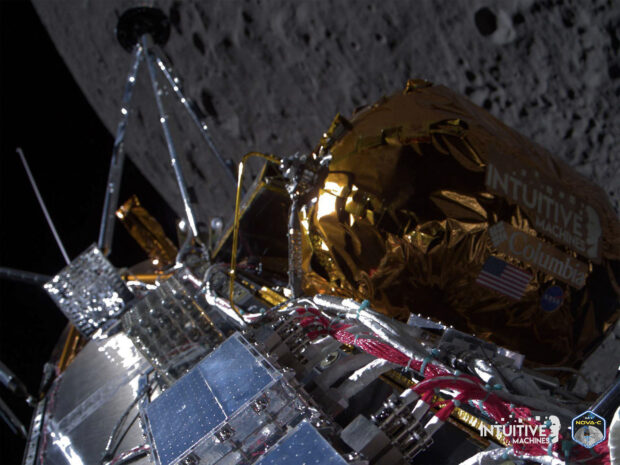American lunar lander ‘alive and well,’ images expected soon

In this photo courtesy of Intuitive Machines, Odysseus passes over the near side of the Moon following lunar orbit during the IM-1 mission on February 21, 2024. An Intuitive Machines Nova-C class lunar lander is bound for the moon, where it will attempt to land near the south pole and carry out experiments that pave the way for the return of American astronauts later this decade. (Handout / Intuitive Machines / AFP) /
WASHINGTON – The first American spaceship on the Moon since Apollo is “alive and well” following a drama-packed touchdown, the company that built it said Friday as it worked to download data and images from the uncrewed robot.
Odysseus landed near the lunar south pole Thursday at 6:23 pm Eastern Time (2323 GMT), after a nail-biting final descent when ground teams had to switch to a backup guidance system and took several minutes to establish radio contact after the lander came to rest.
“Odysseus is alive and well,” Intuitive Machines, which achieved the first lunar landing by a private company, posted on X on Friday morning. “Flight controllers are communicating and commanding the vehicle to download science data.”
The Houston-based company’s stock price soared by 40 percent in early trading before paring back to 24 percent.
Engineers are working to learn the robot’s precise coordinates in the Malapert A impact crater and its tilt, as the landing phase was carried out by the robot autonomously, using its instruments to navigate the Moon’s terrain.
The company said Odysseus, which is the size of a large golf cart, is upright — a relief after the Japanese space agency’s SLIM lander, which touched down in January, ended up upside-down.
Intuitive Machines pledged to soon downlink the first images taken by the lander.
But because of complications associated with the landing, a decision was taken not to shoot out an external camera to capture the landing as it happened, according to Embry-Riddle Aeronautical University, which built the “EagleCam” device.
The camera will now be deployed from the ground to try to obtain a third-person image of Odysseus.
Improvised fix
Odysseus is the first success for a new fleet of NASA-funded lunar landers designed to carry out science investigations that pave the way for the return of American astronauts to the Moon later this decade, under the Artemis program.
A moonshot by another American company last month ended in failure, raising the stakes to demonstrate that private industry had what it took to repeat a feat last achieved by US space agency NASA during its manned Apollo 17 mission in 1972.
Underlining the technical challenges, Intuitive Machines’ own navigation technology failed and ground engineers were forced to jerry-rig a solution, hastily writing a software patch to switch to an experimental NASA laser guidance system that was intended to run only as a technology demonstration.
Confirmation of landing was supposed to come seconds after the milestone, but instead around 15 minutes passed as announcers mused whether the hexagon-shaped craft had come down “off angle.”
Finally, the company’s chief technology officer Tim Crain confirmed “our equipment is on the surface of the Moon and we are transmitting,” as applause broke out in mission control.
Commercial Moon fleet
NASA paid Intuitive Machines $118 million to ship six experiments under an initiative to delegate cargo services to the private sector to achieve savings and stimulate a wider lunar economy.
Odysseus also carries cargo for private customers, including a reflective heat wrapping developed by Columbia Sportswear used to protect the spaceship’s cryogenic propulsion tank.
The United States, along with international partners, are planning to develop long term habitats in the south pole, harvesting ice there for drinking water and for rocket fuel for eventual onward voyages to Mars.
The first crewed landing under NASA’s Artemis program is set to take place no sooner than 2026. China meanwhile plans to put its first crew on the Moon in 2030, in a new era of space competition.
The mission was the fourth attempt at soft lunar touchdown by the private sector. Intuitive Machines joins the national space agencies of the Soviet Union, United States, China, India and Japan in an exclusive club.